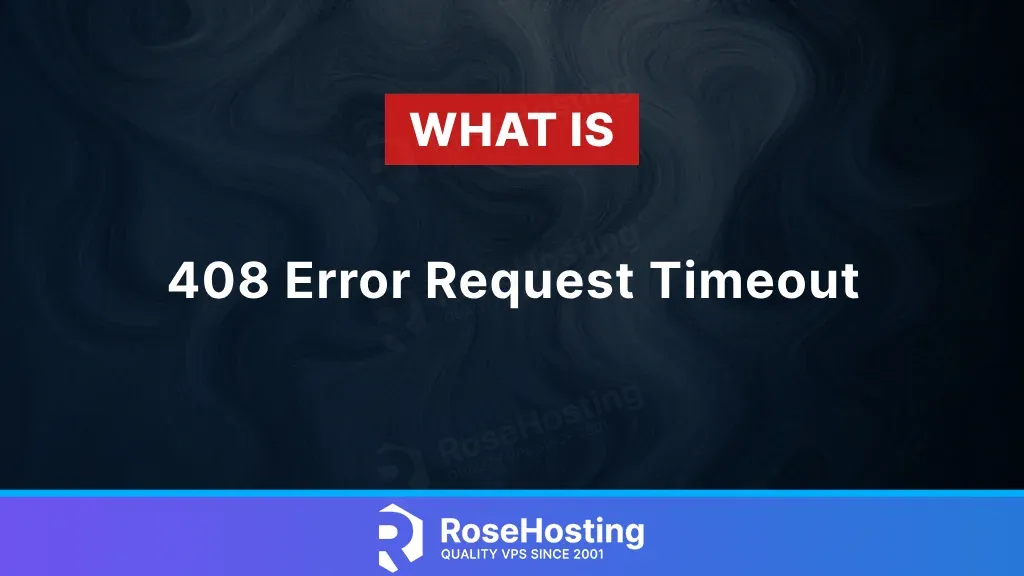
In this blog post, we will explain the HTTP 408 Error Request Timeout and possible solutions to fix it. The HTTP 408 Error or HTTP 408 Request Timeout belongs to the 4xx HTTP request codes and occurs in the browser when a server does not respond to a user’s request in time. The HTTP 408 Error is directly generated by the web server with which the client is communicating. We need to take a couple of steps to fix the issues. In the following paragraphs, we will also cover the common causes and reasons for this error and provide potential solutions. Let’s get started!
Table of Contents
What Is the HTTP 408 Error Code and What Does it Mean?
To clarify things, the HTTP status codes are divided into five categories: informational, success, redirects, client errors, and server errors. The HTTP 408 belongs to the category of client errors. This status code tells us that the server did not receive a timely response from the client and the server timed out while waiting for the request. There are two reasons for this: the server is too busy to process the request or the client takes too long to send the request. So in both cases, the server terminates the connection, resulting in the client receiving the HTTP 408 Request Timeout message in the browser.
What Causes the HTTP 408 Request Timeout Error?
The causes of the HTTP 408 Request Timeout vary depending on different factors. Let’s explain them separately in the paragraphs below:
Network Issue is one reason this status code appears: an unreliable internet connection can delay the requests, leading to a timeout.
Wrong URL: Sometimes, mistyped URLs can confuse the server, and the server will waste time finding that URL to serve the client, leading to a timeout while searching.
Overloaded Server: If the server cannot handle all requests due to insufficient resources, it will struggle to respond to all of them and time out, resulting in the HTTP 408 error.
Firewall is also one reason this error appears: some strict blocking rules on the server block the requests and interfere with the communication between the server and the client.
Wrong Web Server Configuration or settings can slow the request’s processing and cause a timeout. The wrong server configuration can also result in wrong redirects, too many redirects in the loop, redirects to non-existent URLs, etc.
Issues with the Application: Sometimes, wrong database queries, flawed application code logic, etc., lead to an HTTP 408 timeout.
Web Browser Cache: The web browser cache may cause the client to receive the HTTP 408, although everything is OK with the server and the request. The web browser may see the cached and outdated content when the website was inaccessible previously.
How to Fix the HTTP 408 Request Timeout Error?
In the next paragraphs, we will show you some possible fixes for the HTTP 408 Request Timeout Error. Some of the fixes are explained and obvious in the previous heading, where we explained the causes. Let’s first give you some client-side steps to fix the HTTP 408 Error, and then server-side steps.
Clear the web browser cache, cookies, and history, and try again to access the website. An outdated cache can cause many problems, even if everything is OK with the website.
Check the URL you are accessing in the browser. Mistakenly entered URLs can give you results from a different website hosted on other servers.
Disable Web Browser Extensions because sometimes web browser updates or installing new extensions may result in incompatibilities, including the HTTP 408 Error.
These were the client-side possible solutions. Now, let’s proceed with server-side possible fixes.
Check the Web server configuration files where the redirect rules and values are defined, such as KeepAliveTimeout or RequestReadTimeout. If needed, increase these values. Also, it is worth checking the .htaccess file directly if there is one.
Check the Code or Database Queries: Potential bugs in the code may slow down the processing request. Bad database queries may also slow down the processing and cause timeouts. Always seek to have optimized code and optimized database queries.
Check the Server Logs: Checking the server logs can help easily identify the cause of HTTP 408. The server log files contain messages related to the web application’s errors, so it is always a good idea to check the server log files before taking any action.
Conclusion
These are the basic steps to perform to fix the HTTP 408 Request Timeout Error. If the issue is server-related and you are unfamiliar with Linux, contact our technical support. All you need to do is sign up for our Linux VPS plans and submit a support ticket. We are available 24/7 and will be happy to assist you.
If you liked this post about the HTTP 408 Request Timeout status code and how to fix it, please share it with your friends or leave a comment below.
408/Request Time out i keep on getting this error message
i cannot make any external calls please advise how to fix there is still more than enough airtime